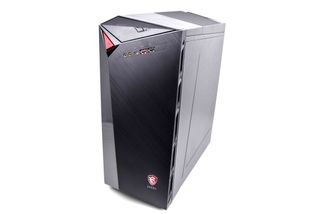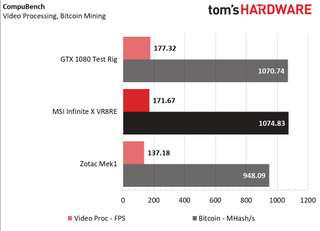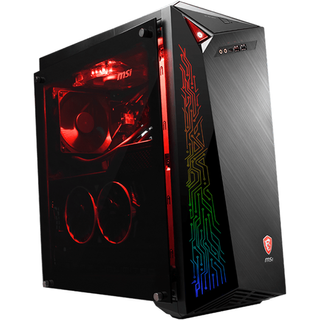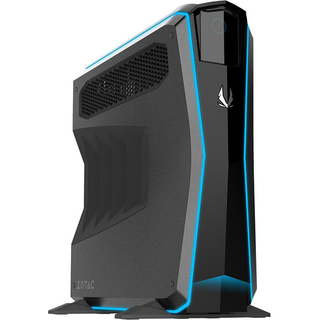MSI Infinite X Desktop PC Review: Edgy Look, Premium Performance
Why you can trust Tom's Hardware
Synthetic, Productivity, and Gaming Benchmarks

We compared the MSI Infinite X VR8RE to the recently reviewed Zotac Mek1 desktop PC, in addition to our test rig (the full specs are below). The Zotac sports a 7th generation Intel Core i7-7700 (locked) processor and a GeForce GTX 1070 Ti but has an MSRP $300 less than the Infinite X VR8RE. The comparison should hash out how much more performance you’ll get from MSI’s next-gen Core i7 and GTX 1080-equipped Infinite X.
Comparison Products
Test System Configuration
The Infinite X was tested using the company’s one-click overclocking settings, which sets the six-core i7-8700K to optimized frequencies based on how many cores are active. Single core performance can reach as high as 5.0GHz, and it dials down as you increase the core count. Dual-core operation is set to 4.9GHz (400MHz higher than the CPU’s base Turbo frequency), 4.7GHz utilizing three-to-five cores, and 4.4GHz with all six cores engaged. The Coffee Lake CPU should easily outperform our stock-clocked Core i7-7700K, which sports a base frequency of 4.2GHz and boosts to 4.5GHz in lightly threaded workloads. However, it should really outshine our aging Z270 reference system in multi-core applications and tests.
The MSI offering’s 16GB (2 x 8GB) kit of Kingston DDR4-2400 features a CAS latency of 17-17-17-39, and the frequency is slightly lower than the Z370 platform’s native memory controller speed of DDR4-2666. This won’t affect most gamers, but bandwidth-intensive workloads may not be up to par with the platform’s full potential.
The GTX 1080 inside the Infinite X is factory overclocked to a base and boost frequency of 1,657MHz and 1,797MHz, respectively, and it should provide slightly better framerates compared to our test rig’s stock-clocked GTX 1080 in GPU-intensive games.
Fire Strike & Time Spy




The MSI Infinite X VR8RE starts our test suite off strong against our previous-gen test bed, netting higher scores in UL’s (formerly 3DMark) Fire Strike and Time Spy synthetic gaming benchmarks. The substantially higher Physics (CPU) scores contribute to the Overall results, and the Infinite X easily pushes ahead of the competition in the field.
Cinebench R15

The Infinite X again makes short work of the other competing systems in the Cinebench R15 Single and Multi-CPU rendering tests. This is especially prevalent in the multi-core benchmark (six cores vs four – obviously), but the MSI contender falls slightly behind our test rig by a pie slice (3.14 FPS, get it?) in the OpenGL Shading tests. This could be due to a slightly slower memory subsystem, but it is within a reasonable variance.
CompuBench

The Infinite X’s performance is also bested by our reference rig in the CompuBench Video Processing tests by a small margin, again pointing to a slight disadvantage with OpenGL workloads against the previous-gen Core i7 at stock clocks. However, the VR8RE’s factory overclocked GTX 1080 gives the X a slight edge in the Bitcoin Mining benchmark.
Storage Test


The MSI Infinite X sports an Intel 600P SSD, the pitfalls of which we have already documented. Not surprisingly, the Infinite X’s PCIe 3.0 x 4 NVMe SSD only narrowly outperforms our test rig’s SATA SSD in sequential read and write performance by about 130MB/s and 70MB/s, respectively.
However, the 600p’s random 4K read speeds are substantially lower than both of the competing systems' SSDs at QD2. The 4K write performance is only slightly below that of our test rig, but only power users with storage-intensive workloads would notice the difference between most SSD classes. Average gamers (whom this product is aimed at) would just be happy to have one in general.
Sandra Memory Bandwidth


Unsurprisingly, the MSI Infinite X doesn’t perform much better or worse than the Zotac Mek1 in the Sandra Memory Bandwidth benchmarks. Both systems sport DDR4-2400, but that’s the standard speed for the Mek1’s Core i7-7700.
MSI could have done better with the memory, and although Kingston is a reputable brand, a kit of RAM with heatsinks and speeds that match the platform’s memory controller would provide a big boost to memory bandwidth-intensive workloads. However, most consumers won’t need more than the 16GB capacity, and raw RAM speed is much less important if the goal is to game.
PCMark 8 & PCMark 10 Extended


The MSI Infinite X finishes the Productivity and Synthetic portion of our suite with impressive performance in the PCMark8 Application and PCMark 10 Extended tests. The PCMark 8 results are derived from real-world workloads using Adobe Creative Suite and Microsoft Office, and the X outpaces our reference machine by about 100 points in both tests. The PCMark 10 Extended tests are purely synthetic, but they paint a similar picture – the MSI Infinite X has some moderate productivity chops thanks to its overclocked CPU.
Gaming Benchmarks







The MSI Infinite X VR8RE maintains its dominance over our test rig and the Zotac Mek1 with its overclocked Core i7-8700K and factory overclocked GTX 1080 in the gaming benchmarks. Titles such as Ashes of the Singularity: Escalation, DiRT Rally, and The Division see significant performance gains from the VR8RE’s overclocked (one-click CPU, factory GPU) components, but the advantages are less pronounced in Bioshock Infinite, GTAV, Middle Earth: Shadows of War (where it performed identically to our Z270 test bench), and Rise of the Tomb Raider. Overall, the Infinite X offers impressive gaming performance adept for ultra-high settings at 1440p and 4K with less eye candy turned on.
Configuration Options
The MSI Infinite X has several different configurations, but all of them feature an Intel Core i7-8700K, a Z370 motherboard, and 16GB of DDR4-2400 memory. You can get the Infinite X with a GeForce GTX 1070, a 256GB NVMe SSD, and a 2TB HDD starting at $1,499. Our review unit sports a GTX 1080 with a 512GB NVMe SSD (no HDD) for $1,899, and the top of the heap features a GTX 1080 Ti with a 512GB NVMe SSD and a 2TB HDD for $2,199.
Bottom Line
The MSI Infinite X is designed for gamers looking for an edgy RGB LED-illuminated chassis with a tempered glass side panel, top-tier components, and easy to use (and pre-installed) overclocking software. However, this premium desktop is not without flaws, including some dangling wires on the inside (due to a loose clip), a mediocre SSD and a RAM that could be faster. However, at $1,899, the VR8RE model is reasonably priced, especially when you consider its high end hardware. If you want a prebuilt desktop with strong performance and flashy aesthetics, the MSI Infinite X is a compelling choice.
MORE: Best PC Builds
MORE: How To Build A PC
MORE: All PC Builds Content
- 1
- 2
Current page: Synthetic, Productivity, and Gaming Benchmarks
Prev Page Introduction and Product TourStay on the Cutting Edge
Join the experts who read Tom's Hardware for the inside track on enthusiast PC tech news — and have for over 25 years. We'll send breaking news and in-depth reviews of CPUs, GPUs, AI, maker hardware and more straight to your inbox.
-
electronicbineries It looks ugly, The front I/O ruins the look of it .Reply
MSI should look into small Details like these... you made a good looking case to ruin it with the look and position of the front I/O ...


